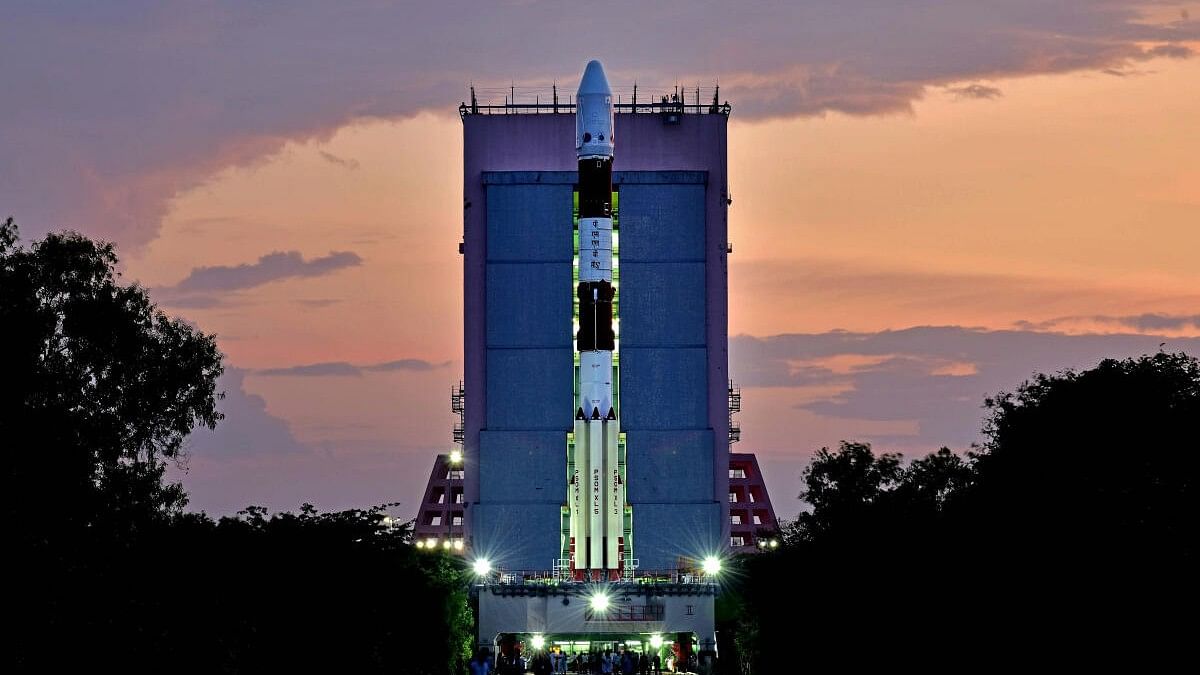
Preparations in the final phase for India's maiden solar mission, Aditya L1 onboard the PSLV-C57, ahead of its launch.
Credit: PTI Photo
The Indian Space Research Organisation (ISRO) is literally aiming for the stars by launching a probe to study Earth’s nearest star, the Sun.
India’s first mission to the Sun, Aditya L1, carried by the Polar Satellite Launch Vehicle (PSLV)-C57 rocket, comes close on the heels of the Chandrayaan-3 mission that soft-landed on the Moon’s south pole. Aditya L1 underlines ISRO’s soaring confidence as a space agency capable of successfully launching interplanetary missions.
It will take four months for Aditya L1 to get to its designated parking slot Lagrange point 1 (L1), or L1, which is 1.5 million km from Earth where the gravitational pull of the Sun and Earth equals the centripetal force necessary for the spacecraft to move with them. At L1, the probe will begin a highly stable ‘halo orbit’ which enables it to study the Sun continuously without being interrupted by any occultation of the Sun by other celestial bodies. The probe is carrying seven payloads: four of them to directly view the Sun, and the other three to study particles and fields at L1.
ISRO’s space missions — be it remote sensing satellites or communication satellites — are national missions with a focus to benefit people in some way or another. These acquired international colours when ISRO collaborated with other spacefaring nations for interplanetary missions such as ISRO ’s Moon and Mars probes that carried payloads from abroad as well. In the case of Aditya L1, the seven payloads have been developed indigenously to better understand solar phenomena, and its impact on Earth.
Not much is known
The Sun is an ordinary star by galactic standards, one among billions of similar yellow stars in the Milky Way. Never mind if it accounts for 99.8 per cent of the Solar System, and could easily house a million Earths inside it. Like all stars, it is extremely dense — so dense that light cannot escape easily. So, the sunlight reaching us now actually started out from its interior hundreds of thousands of years ago when woolly mammoths and sabre-tooth tigers roamed Earth. But this sunlight took just eight minutes to cross the 150 million km to Earth!
The Sun’s moderate size and location at the edge of the Milky Way not only makes life on Earth possible, but the immense solar gravity protects the planet by nudging comets and space rocks off potential collision courses. Yet, despite life on Earth depending on it, the Sun remained on the periphery of human investigation for a long time, and many of its characteristics are still a mystery.
Not much is known either about the Sun’s upper atmosphere and the ‘solar wind’, a continual stream of protons and electrons from the Sun's outermost atmosphere, the corona, which drives space weather. Ditto for coronal mass ejections (CMEs), comprising large clouds of plasma and magnetic field, erupting from the Sun. Sunspots, another unknown, are regions on the Sun's surface where energy flow from the interior is reduced by strong magnetic fields, making them 'cool' at about 1,500 degrees C. This makes them appear relatively 'darker' than their surroundings at 6,000 degrees C. Scientists are baffled why sunspots peak every 11 years ('solar maximum') when solar flares and the CMEs explosively spew billions of tons of charged particles from the Sun's outermost layer.
Why the Sun?
Earth’s magnetic field is not always constant, and when it is weakened, the CMEs create geomagnetic storms that disrupt electrical and communications systems, with surges in power lines and cables over long distances. Radiation storms swirl around Earth and red auroras shimmer in the skies as the CMEs interact with Earth’s magnetic field. The magnetic storm by itself does not pose a danger to terrestrial life, thanks to the ionised solar particles being absorbed, or bounced off, by Earth’s atmosphere. But this does not reduce the sunburst’s nuisance value any as it affects ground and space high-tech systems by disturbing Earth’s ionosphere — the electrically charged atmospheric layer used to bounce high-frequency radio signals. So, even if computers and sundry electronic equipment (that do not depend on wireless transmission) remain unaffected, mobile phones (that do depend on radio transmissions) may go on the blink, just as invaluable data from orbiting satellites could be lost.
In the last 20 years, international interest in the Sun has picked up, prompting several solar exploratory missions. NASA led the field with several probes followed by Japan, Europe, Russia, and China. These missions were equipped with state-of-the-art instruments on the ground, and in space, to study the Sun’s nuclear and plasma physics and magnetohydrodynamics. The most spectacular mission yet is NASA’s Parker Solar Probe launched in August 2018; in December 2021, the spacecraft flew through the Sun's upper atmosphere and corona where temperatures average a million degrees Celsius to study their structure and magnetic fields.
Aditya-L1 will soon join this select group of Sun-watching robots, whose research will improve our understanding of the Sun. This, in turn, will help study other stars (particularly those with planets) and help scientists forecast space weather, which is so important for space exploration.
(Prakash Chandra is former editor of the Indian Defence Review. He writes on aerospace and strategic affairs.)
Disclaimer: The views expressed above are the author's own. They do not necessarily reflect the views of DH